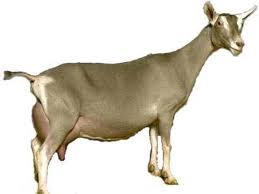It is quite certain that the goat was one of the first domesticated animals in Western Asia. He is thought to have descended from the Pasang or Grecian Ibex, a species of wild goat found in Asia Minor, Persia, and other nearby countries. Old Testament verse mentions the goat more than 150 times. Dairy goats are not nearly as numerous as dairy cattle in the Europe, but, for many other countries of the world, they are the leading milk producers because they are well adapted to limited areas and require less specialized feed, most of which can be produced by the small land owner. There are actually more people consuming dairy goat products in the world than those consuming the products from dairy cattle.
Alpine –The French-Alpine is a breed of goat that originated in the Alps. The goats of Alpine type that were brought to the United States from France where they had been selected for much greater uniformity, size, and production than was true of the goats that were taken from Switzerland to France. These are hardy, adaptable animals that thrive in any climate while maintaining good health and excellent production.
Alpines can be almost any color except solid white and light brown with white markings (toggenburg color); their face should be dished or straight. They have erect ears and are a medium-large breed. They are popular with dairies due the amount of milk they produce. I have found them to be generally friendly and sweet, even raised on their dam, with high milk production. Pictured below is an Alpine doe.
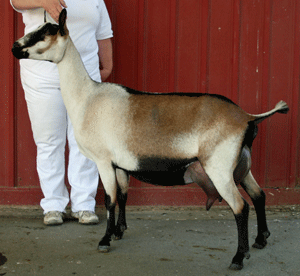
LaMancha - Is a type of dairy goat noted for its `lack` of or much reduced external ears. The La Mancha breed is medium in size, and is also noted for a generally calm, quiet and gentle temperament, high butterfat content to the milk and good production.The LaMancha goat was developed in the 1930`s in Oregon by Eula F. Frey when she crossed some short-eared goats of unknown background with her outstanding Swiss and Nubian Bucks. The La Mancha has excellent dairy temperament and is an all-around sturdy animal that can withstand a great deal of hardship and still produce. Through official testing this breed has established itself in milk production with high butterfat.
LaManchas have ears that are so small that it looks like they don't have ears and they can also be any color. They have a straight nose and are a small to medium breed. The LaMancha sound is typical of other goats. When you own a LaMancha, be prepared to answer the question 'What did you do to its ears?' This is one breed I have never owned. I have heard they are friendly goats but I can't get past the ears.... Picture below is of a Lamancha doe.
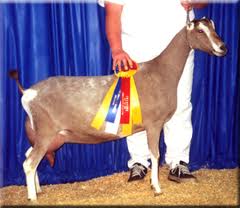
Anglo-Nubian - This breed originated in England as a cross between the Old English Milch Goat and the Zariby and Nubian bucks imported from India, Russia, and Egypt. They have been exported to most countries from England and are sometimes referred to as "nubians" instead of the proper title of "Anglo-Nubian"The Nubian breed leads the way for the dairy breeds in butterfat production: it produces on average, 5% or more butterfat content.
Nubians have very long, floppy ears and they can be any color. They have a convex nose and are one of the larger breeds of goats. Their milk tends to be higher in protein and butter fat than other breeds. They make a distinctive sound. Even Nubian kids sound like they are complaining. Some people think they tend to be a little bit more stubborn than other dairy goats but I find them to be very sweet and easy to bond with, if just a bit needy and clingy. I have found them to have wonderful milk production. Nubians are one of my very favorite breeds of goats. Pictured below is Creme Puff, owned by Nubilop Acres, and dam of one of our wonderful girls! :)
Oberhasli - Is a dairy goat from the eponymous district of the Canton of Berne (Switzerland). Oberhasli are reddish brown in color with a black dorsal stripe, legs, belly, and face. This breed is a good choice for the person who wants a dairy goat, appreciates its vivid coloration, wants something slightly out of the ordinary, and who wants a quiet and gentle breed.
Oberhaslis have very specific color standards. They are a bay color, known as Chamoise, with a black dorsal strip, udder, belly, and black below the knees. They should also have a nearly black head. Another aceptable color would be all black but this is only acceptable for does. They have erect ears and are a medium-small breed. I have only owned Oberhasli crosses and have found them to be a little pushy but friendly. Picture below is a Oberhasli doe.
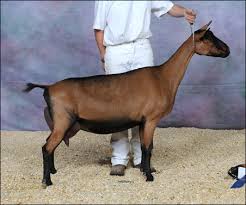
Saanen - The Saanen breed is white in color and the largest of the dairy breeds. Does typically weigh 150 lb (68 kg) or more, with bucks weighing over 200 lb (91 kg). The Saanen breed also produces the most milk (as a breed- there will be good and poor individuals in any breed) and tends to have a lower butterfat content, about 2.5%-3%. The Sannen temperament is as a rule, calm and mild mannered.
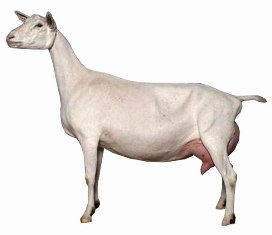
Toggenburg - Is a breed of goat, named after the region in Switzerland where the breed originated, the Toggenburg valley. Toggenburgs are medium in size, moderate in production, and have relatively low butterfat content (2-3%) in their milk. The breed standard is brown with white legs, facial stripes, muzzle, ears, and tail patch. Wattles, small rudimentary nubs of skin located on each side of the neck, are often present in this breed.
Toggenburgs also have very specific color requirements. They are light brown and have white ears and lower legs. The side of the tail and two stripes down the face must also be white. They have erect ears and have the smallest height requirments of all the breeds, but most are pretty good size. They can grow a shaggier coat than other dairy goat breeds. They also are popular with dairies. Some people feel they tend to be a little wilder and more high strung than other breeds. I have only had two but found them sweet and calm. Pictured below is a Toggenburg doe.
